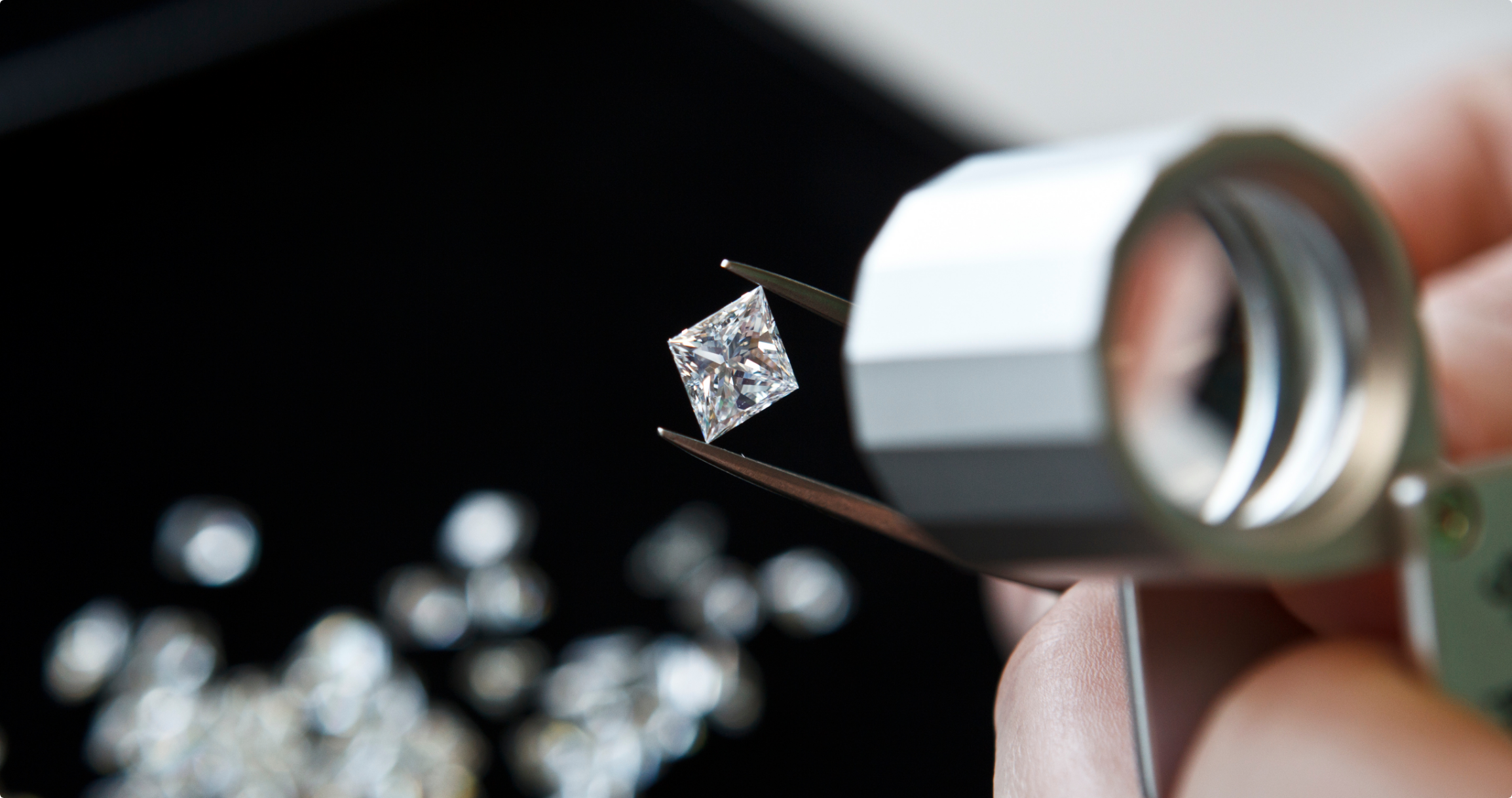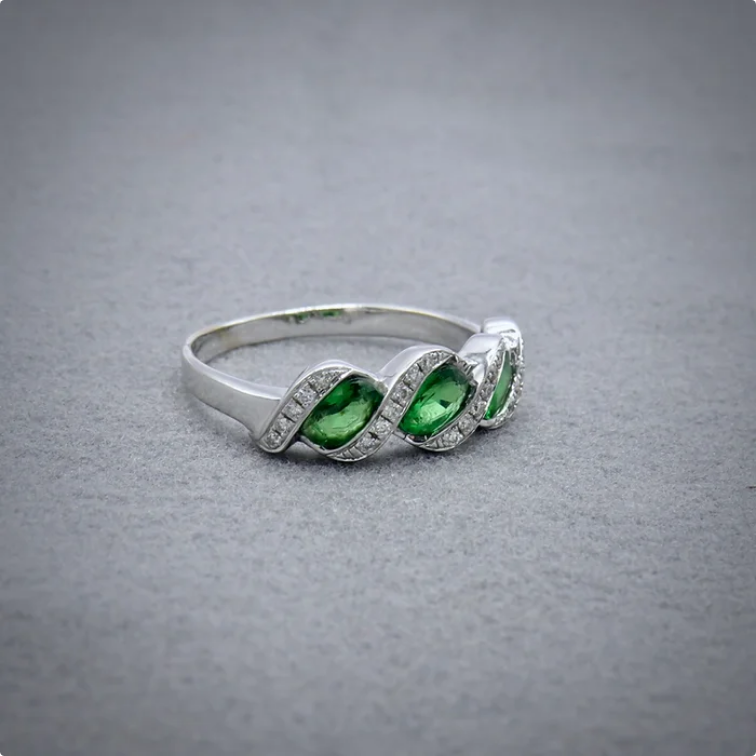The 4Cs: What it Means For Your Diamond
Even if you’ve never had any interest in Diamonds until it came to thinking about a bespoke piece of jewellery, the likelihood is you’ll have heard the phrase ‘the 4Cs’. But what do these 4Cs mean and how important are they? Here, we delve into each ‘C’ and give you a bit more insight into this well-known phrase.

A common misconception is that cut refers to the shape of a diamond (round, oval, pear, marquise etc) when in fact it refers to how well light interacts with the facets of the stone. This is arguably the most important of the 4Cs as the cut directly affects the sparkle of a diamond.
The way a diamond is cut can have a big impact on the clarity and the colour of the stone too. It takes a lot of skill for the proportions, symmetry and polish to deliver the most dazzling diamond possible. Brightness, fire and scintillation are delivered to their optimum when light reflects back through the crown, which is why a well-cut diamond is so important. A diamond that is cut too deep or shallow won’t reflect light through the crown, thus making it appear dull.
Where it all began
For a long time, there was no agreed-upon standard for ranking diamonds and evaluating their worth. Robert M. Shipley, the founder of the Gemological Institute of America (GIA) introduced the 4C scale in the 1940s to help give the industry some consistency. The 4 Cs are: Cut, Colour, Clarity, and Carat. They have become the benchmark as the value factors for a diamond and how their price is determined.
Cut
A common misconception is that cut refers to the shape of a diamond (round, oval, pear, marquise etc) when in fact it refers to how well light interacts with the facets of the stone. This is arguably the most important of the 4Cs as the cut directly affects the sparkle of a diamond.
The way a diamond is cut can have a big impact on the clarity and the colour of the stone too. It takes a lot of skill for the proportions, symmetry and polish to deliver the most dazzling diamond possible. Brightness, fire and scintillation are delivered to their optimum when light reflects back through the crown, which is why a well-cut diamond is so important. A diamond that is cut too deep or shallow won’t reflect light through the crown, thus making it appear dull.

GIA Cut Scale
Colour
Following the introduction of the 4Cs, Richard T. Liddicoat developed the colour grading scale at the GIA in the 1950s. It ranges from D-Z and represents a range of colours that are based on tone and saturation. But why does the scale not start at A? Well, the GIA wanted to distance themselves from any previous systems that came before, hence starting at D!
In smaller carat weights, like 0.25 and under, only a trained grader can tell between D-F range and not when in a setting. This is because a mount can impact the perceived colour too. A yellow gold makes the slight amounts of yellow and brown less obvious, but a white metal makes colour more obvious. Also, when mounted, a G, H or I diamond might look colourless face up. In terms of colour and value, if all other factors are equal except the colour, the better the grade, the more expensive the stone.
Diamonds also come in several other ‘fancy’ colours including red, blue, green, pink, grey and black as well as yellow and brown. The colour depends on the impurities present, but red, purple and green are the rarest.

GIA Colour Scale
Clarity
A natural diamond has been formed in the earth for millions of years and it may not be entirely ‘perfect’. Internal features, known as inclusions, and surface features, known as blemishes, combine to make clarity characteristics.
Therefore, clarity is looking for the relative absence of these features. Ultimately, no two diamonds have the same characteristics – each is unique. Like colour, there is a grading system for clarity as well. It ranges from Flawless to I3 and each grade in relation to the other Cs will have an impact on the price of a stone. A flawless stone, no inclusions or blemishes under 10x magnification, is very rare and hence thereis a strong relationship between clarity, rarity and value.

GIA Clarity Scale
Carat
Carat is the one most people know about, but carat does not refer to the size of the diamond, but the weight! The term originates from the days when carob seeds were used as counterweights. In the early 20th Century, carat was standardised as 0.2g and the metric carat is divided into 100 points, where one point is 0.01 carat. So 50 points would be 0.5 of a carat. Carat weight, although a universal term for all gemstones, does not mean that a 1ct diamond and a 1ct sapphire will visually be the same size, due to the varying density of the stones.
There are some industry standard dimensions of each shape of diamond to denote weight, but it’s not exact because it all comes back to the cut of the diamond as well. Often different shapes of stones will play a factor in how big a stone ‘looks’. The surface area of a pear shape for example, may make it appear larger than its round brilliant counterpart.
Carat weight of a stone does play a big part in the cost. The larger a diamond, the rarer they tend to be, so the more expensive. Over a carat drastically impacts the price and visually you would be hard pushed to tell the difference between a 0.96ct stone and a 1.02ct stone! We find it helps to think about the actual dimensions (mm) of each stone rather than focusing on the carat weight.

GIA Carat Weight Scale
What it Means for your story
Every diamond is unique, so what the 4Cs mean for your jewellery will depend on your story. There is no right and wrong when it comes to the diamonds you choose, as long as you are making an informed decision. Most people end up trading one element to achieve another which they deem to be the most important to them for the budget that they have. For example, if carat weight is the important element, then clarity or colour may slide down the scale slightly to accommodate it. It’s all about balance. We are here to help you understand what diamond is right for you and you may be surprised that the one you fall in love with isn’t the biggest or the best colour! Get in touch to start your story.
Related Items

Stand Out from the Crowd: Alternative Gemstones
They say Diamonds are a girl’s best friend, but maybe they aren’t after all…
Jewellery Trends in 2024: The Must- Have Styles
Jewellery can be timeless, or it can be on trend. There is nothing wrong with being inspired by what is trending.